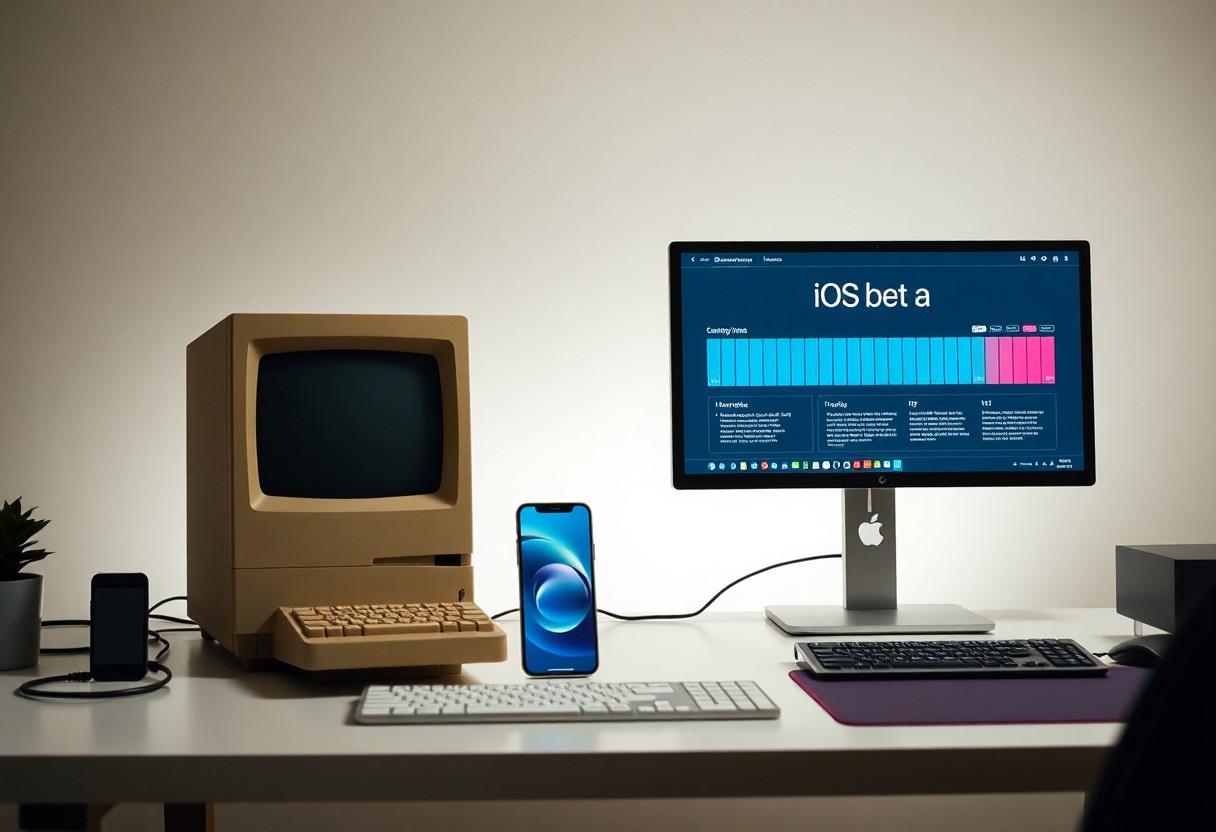Just as technology continues to advance, so does Apple’s iOS, transforming your mobile experience with each iteration. In this post, you will explore the significant public beta releases that paved the way for the much-anticipated iOS 26. By tracing the evolution of this operating system, you’ll gain insights into how each version has shaped the features and functionality available to you today, allowing you to fully appreciate the advancements that make your Apple devices more powerful than ever.
The Genesis of iOS: Early Versions and Public Reception
The launch of iOS in 2007 marked a pivotal moment in mobile technology, radically transforming how users interacted with devices. Early versions, particularly iOS 1, introduced a minimalist design and an intuitive touch interface that resonated with users, leading to widespread adoption. In the years that followed, each release refined this experience, resulting in a dedicated community of enthusiasts eager to explore new features and functionality. Your feedback became an necessary part of this evolution, shaping iOS into the powerhouse it is today.
Groundbreaking Features of iOS 1
iOS 1 set the stage for innovation with features like the App Store, visual voicemail, and multitasking capabilities, which were especially groundbreaking at the time. The introduction of apps allowed developers to create tailored experiences for users, something that changed the landscape of mobile applications forever. You could easily customize your device to fit your lifestyle, giving you greater control over how you engage with your smartphone.
Community Feedback and Impact on Development
The inception of iOS was heavily influenced by user feedback. Apple’s willingness to listen and adapt played a critical role in shaping subsequent versions, with forums and online communities providing insights into user preferences and pain points. Your voice connected with developers, driving improvements and new feature rollouts that continually enhanced the iOS experience.
Your feedback during the early days of iOS was instrumental in steering the platform’s trajectory. As users shared their experiences and suggestions, Apple took note, often integrating popular requests into future updates. This collaborative approach fostered a sense of connection between the company and its community, creating a user-driven roadmap that kept iOS responsive to real-world needs. Feedback mechanisms evolved, and with each update, you witnessed how your insights directly influenced the product, ultimately leading to a more polished and customer-centric operating system.

The Beta Era: How Public Testing Changed the Game
Public beta testing revolutionized the way Apple developed and refined iOS. By allowing users to actively participate in the testing phase, Apple gained invaluable insights and real-world feedback that shaped future updates. This approach facilitated a collaborative relationship between the company and its users, ultimately resulting in a more polished and user-centric operating system. The evolution of iOS can be traced significantly through these beta stages, showcasing how public input became an integral part of Apple’s innovation strategy.
The Role of Public Betas in Shaping iOS Features
Your involvement in public beta testing has directly influenced the design and functionality of many iOS features. Users provide feedback on everything from interface adjustments to app performance, ensuring that new updates align closely with user expectations. This iterative process has allowed Apple to identify bugs early and make adjustments, keeping user experience at the forefront of development.
Notable Enhancements from iOS 3 to iOS 9
iOS progressed significantly from version 3 to 9, showcasing some remarkable enhancements influenced by public feedback. Features like multitasking, native email support, and the introduction of the App Store were all pivotal moments in iOS history. Each version added substantial improvements, such as improved Siri functionality in iOS 5 and the introduction of HealthKit in iOS 8, which transformed the ecosystem and enhanced user experience.
The leap between iOS versions 3 and 9 was marked by pivotal enhancements that responded to user needs and demands. iOS 3 introduced the App Store, which transformed the mobile application landscape, giving users access to thousands of applications. By iOS 5, features such as Notification Center and iCloud streamlined user interactions and data synchronization across devices. The introduction of Apple Maps and advanced Siri in iOS 6 brought voice commands to the forefront, while iOS 8’s HealthKit and HomeKit laid the foundation for smart health and home automation solutions. Each iteration built upon user feedback, reflecting a commitment to continuous improvement and responsiveness in design.
The Rise of User-Centric Design: iOS 10 to iOS 14
The shift towards user-centric design marks a pivotal chapter in iOS’s evolution. Beginning with iOS 10, Apple began emphasizing personalization and intuitive interfaces, allowing you to tailor your device experience. By iOS 14, features like the App Library and home screen widgets exemplified how the user experience became a priority, focusing on accessibility, aesthetics, and fluidity in your daily use.
Evolution of User Interface and Usability
Your interaction with iOS has drastically evolved. iOS 10 introduced redesigned notifications and the emphasis on simplify access to information, while iOS 11 refined this with a more cohesive navigation structure. The visual language became more vibrant and engaging, reinforcing usability through elements like the revamped Control Center and improved multitasking features in iOS 14.
Inclusivity in Beta Programs: Broader Participation and Feedback
As beta programs expanded, Apple invited a diverse range of participants to offer feedback, transforming your experience of iOS. With public beta access starting from iOS 10, millions of users engaged in the testing process, allowing for a richer pool of insights, innovative ideas, and practical suggestions. This inclusivity ensured that updates were more reflective of user needs.
This broadened participation was instrumental in shaping features that felt truly representative of user preferences. For instance, feedback from a variety of demographics helped inform changes in accessibility features across iOS 14, enabling Apple to introduce more robust options tailored to users with disabilities. The dialogue between Apple and its users evolved, leading to an agile development framework that not only focused on aesthetics but also prioritized functional improvements that met the expectations of all users. By integrating your voices and ideas into the beta releases, Apple demonstrated how technological evolution can benefit from collaborative innovation.
The Path to iOS 26: Innovations Born from Public Input
The journey to iOS 26 has been significantly shaped by user feedback collected from public beta releases. This iterative process not only enhances product functionality but also empowers users, giving them a voice in shaping the features they desire. Each beta cycle introduces opportunities for you to test new functionalities early, while Apple closely analyzes your input to guide development decisions, ultimately leading to a more refined and engaging user experience in the final release.
Analysis of Trends in Recent Releases
Recent releases of iOS exhibit trends that prioritize privacy, customization, and integration of AI-driven features. For example, with the introduction of new privacy settings in iOS 14, users gained greater control over app permissions, demonstrating a significant shift towards transparency in data handling. These modifications reflect a growing demand from users for empowerment over their devices and data.
Anticipated Features and Community Influence
As the iOS community eagerly anticipates iOS 26, many feature requests stem directly from user feedback, illustrating the profound impact of public influence. Features such as enhanced multitasking capabilities, deeper customizations for the home screen, and further integration of intelligent automation tools are top-of-mind for users. Apple continually assesses feedback trends, helping ensure that forthcoming updates resonate closely with what you, as a user, are looking for in terms of functionality and usability.
In fact, the anticipated features of iOS 26 have emerged from a comprehensive analysis of your feedback across various platforms, with requests amplifying the demand for productivity enhancements and seamless user experiences. Community-driven forums and beta testing feedback provide rich insights, enabling Apple to refine and prioritize new functionalities based on the collective desires of their users. Future iterations promise to uphold this collaborative approach, fostering a direct relationship between Apple and its dedicated user base.
Expert Opinions: Insights on the Evolution of iOS
Interviews with Developers and Industry Analysts
Through conversations with developers that have worked on iOS, you gain first-hand insights into the challenges and triumphs of each beta release. Developers emphasize how every iteration, from the initial public beta to the current iOS 26, reveals a thoughtful evolution in user experience and security features. Analysts highlight the strategic roadmap Apple follows, often using public feedback as a crucial tool to guide enhancements, ensuring that user expectations align with innovative offerings.
Reflections on Future Directions and User Expectations
The trajectory of iOS suggests an exciting future shaped by user-centric innovation. As features like augmented reality and machine learning gain prominence, you can anticipate a shift toward more personalized experiences and seamless integration across devices. Increasing focus on health and privacy also indicates that user expectations will center on security alongside versatility, shaping how developers approach app design. As a user, staying informed on these trends will empower you to leverage future updates fully, enhancing your iOS experience.
The evolution of iOS reveals a commitment not only to technological advancement but also to creating a more intuitive environment for users. Future updates aim to bring enhanced personalization, adapting to your habits and preferences while prioritizing privacy and data security. As developers incorporate AI and machine learning capabilities, you can look forward to truly intelligent devices that understand your needs better than ever before. The anticipation surrounding these developments will undoubtedly shape your user experience, making it imperative to stay engaged with emerging trends and features.
To wrap up
Now that you’ve explored the evolution of iOS through its public beta releases leading up to iOS 26, you can appreciate how each iteration has shaped the user experience and functionality of your devices. Understanding these changes not only enhances your knowledge but also empowers you to make the most of your iOS environment. As Apple continues to innovate, staying informed about these developments will help you adapt and evolve alongside your technology.







